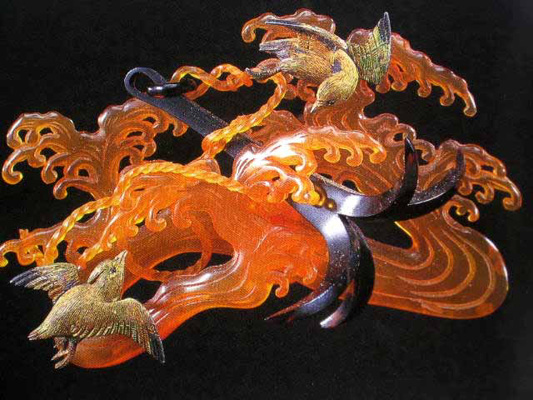There have been some lovely things on ebay recently.
A wonderful 14K gold griffin on a silver base, attached to a tortoiseshell comb sold for $550 on Sept. 27. It has a diamond in its mouth, diamonds on the wings, and a ruby cabachon eye. You may refer to Item #170151496226.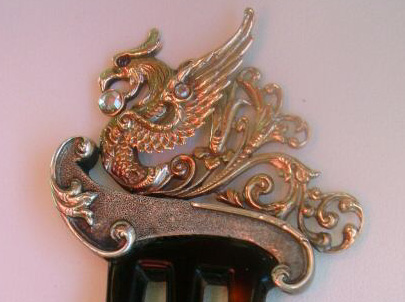

A beautiful Meiji silver-and-gold kanzashi set depicting a bowl, vase, and spoon sold for $465 on Sept. 26. Only one is pictured here so you can see the closeup. You may refer to Item #300153292268.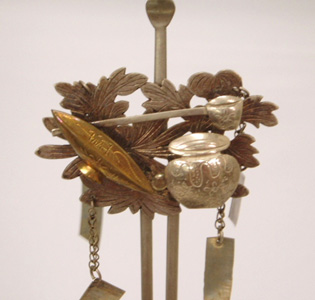
This Victorian garnet tiara hinged on a tortoiseshell comb just sold for $308 on Sept 24. Excellent price for such a lovely star-laden tiara design.You may refer to item #170150463040.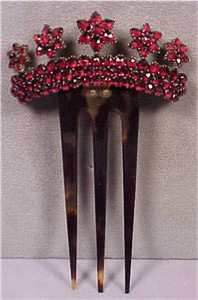
This beautiful Edo kogai stick sold for $660 on Sept 17. It is made of tortoiseshell and decorated with apricot flowers. If you look at the closeup, you can see that little bell flower with the pistels. These painted flowers have the same design as the carved flowers on both shell kanzashi, and the bakelite kanzashi from those Japanese wedding sets they made in the 1940s. You may refer to item #110168679851.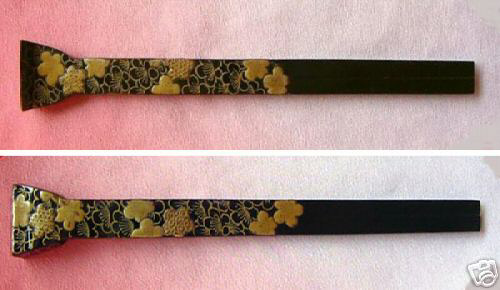
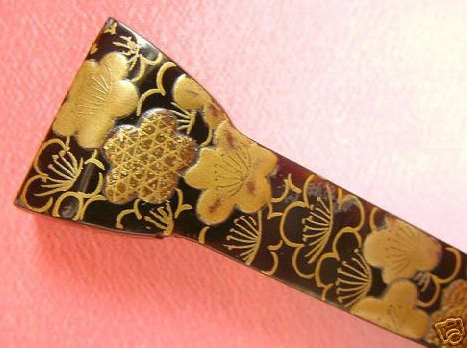
This ivory Edo kogai stick with gold maki-e paint and inlaid jade and coral sold for $300 on Sept. 17. You may refer to Item #330164680560.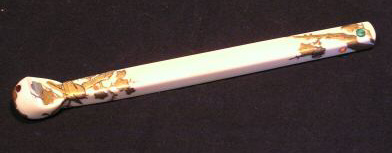
This lovely carved shell floral design on a Meiji set went for $152 on August 30. The stick in between the kogai pieces is wood. There are bug bites on the shell kushi, and that brings the price down considerably. In perfect condition, this would have gone much higher, but I thought $152 was an excellent price for this.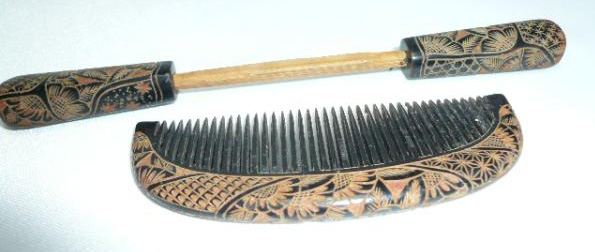
This is a gorgeous piece. The Meiji tortoiseshell kushi depicts waves and is inlaid with pearl. Excellent Condition. It sold for $646 on Sept 22. You may refer to Item #300151918225.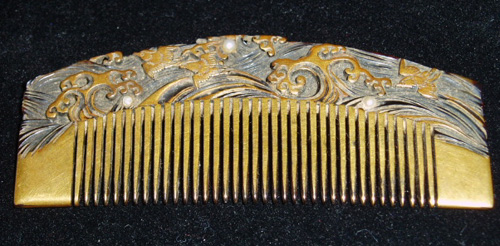
And finally, for today :-), this beautiful Victorian ivory comb sold for $355 (I lost, sadly) on Sept 21. You may refer to Item #290161590846.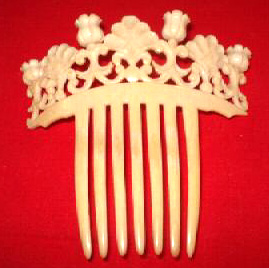
Broken Kanzashi, Broken Heart
Recently, I bought a real shell kanzashi for $214.50. Given the prices Japanese combs are going for on ebay now, I was thrilled to get a real shell kanzashi for a price I could afford. I begged the seller to wrap it properly. I told her a story of when I paid $600 for a real shell kanzashi from Kyoko at Trocadero. It was of a bat. She wrapped it in an envelope, and it came broken. I haven’t been able to find one I liked for what I could afford since then, maybe 3 years ago. Here is what I bought. Shipping cost for me? $14.
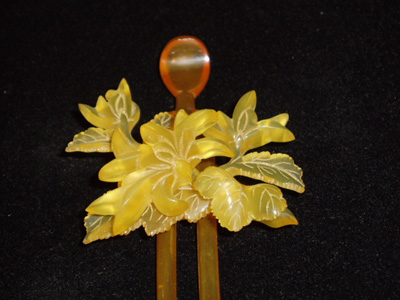
Here is how it arrived: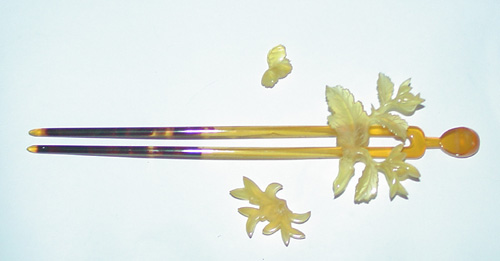
For $14 shipping, it was sent in the smallest-sized priority mail box, wrapped in a few sheets of bubble wrap, with a few popcorn things, and the actual piece was wrapped in what I believe is toilet paper. Sure, I’ll send it back and get a refund, but what the ****. Toilet paper? And a small box, when I begged them? I am just so furious at this moment I could scream. It was a beautiful art piece that survived 100 years in tact. Now, it’s ruined.
Holding Hands
One of the most beautiful innovations of art nouveau design occurs when an artist translates the relationships between animals and plants into a piece of jewelry: one flower petal leaning over to touch another, birds in an embrace. The relationship is then formed not only into art, but also into function. Here are two combs, which illustrate this beautifully.
On the left is a pair of fan-shaped leaves by Louis Aucoc, c.1900. They are made of green plique-à-jour enamel with small rose-cut diamonds in the veins. It sold for $32,400 on April 25, 2006, in New York. On the right, two silver cranes embrace to make this imaginative comb by Hugue. As you can see, the legs of the crane function as the comb, which sold for 1200 GBP on February 22, 2006 in London. Both came from Sothebys.
Some English Diamonds
Although conservative and tiara-like in design, diamond and shell Victorian and Edwardian combs are still breathtaking. I love them. Here are three that sold at Sotheby’s last year.
Pearl and Diamond hair comb; c. 1890; sold 13,200 GBP; 29, June, 2006; London.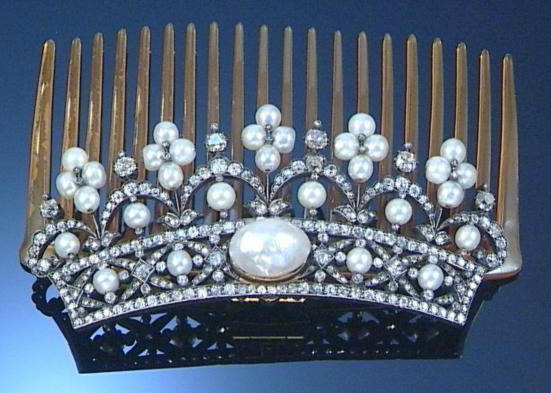
Diamond and blonde shell comb; c. 1910; sold 15,600 GBP; 15, December, 2006; London.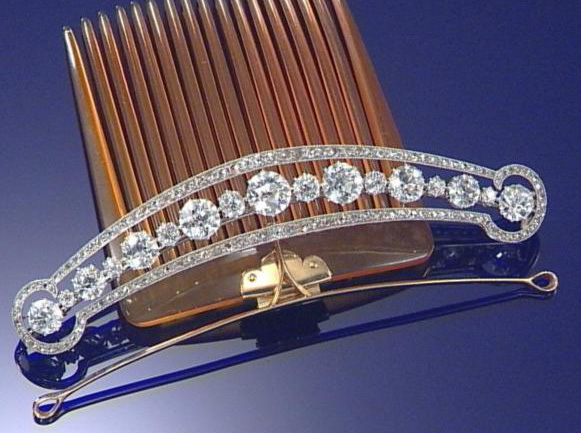
A golden eagle and serpent engaged in combat top this dark tortoiseshell comb, c. 1850. It is decorated with green and white enamel, and ruby and pearl highlights. Sold 3000 GBP; 29, June 2006; London.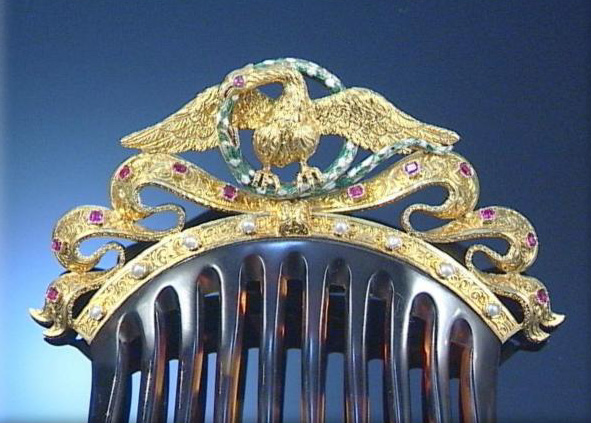
Hair Comb Exhibit at the Lalique Museum in Hakone, Japan
After the opening up of trade routes to Japan, Edo combs were introduced at the Paris exhibition of 1867. They took the European art world by storm and began a craze in France called Japonisme . Western artists noticed the strong Japanese relationship with nature, which produced jewelry that was at once delicate and powerful. Rene Lalique was heavily influenced. He chose comb motifs (swallows, hanging wisteria) and materials (horn), which were common in Japan but shunned in Europe at the time.
It is interesting to compare his famous work Two Swallows with a Stalk of Oats c. 1906-1908, carved horn gold and diamonds, with a Meiji kanzashi of plover birds. In Swallows, Lalique takes the Japanese motif to a new level of inventive design and composition. 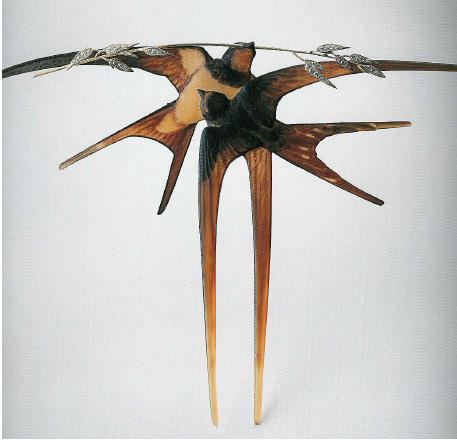
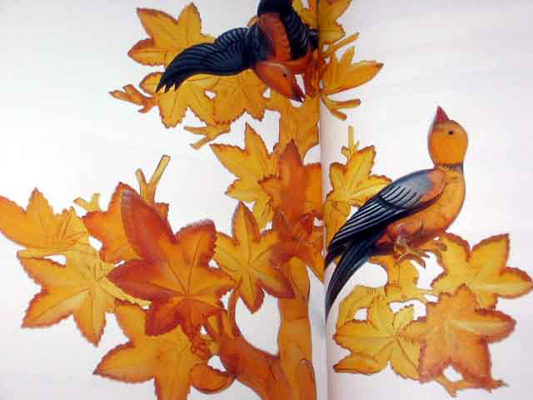
In this comb housed at the RijksMuseum in Amsterdam, Lalique makes Guelder rose flowers on stems of translucent horn. Apparently, they are so fragile that the flowers of diamond clusters seem to be bending the leaves.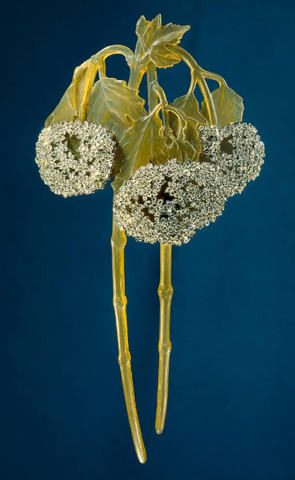
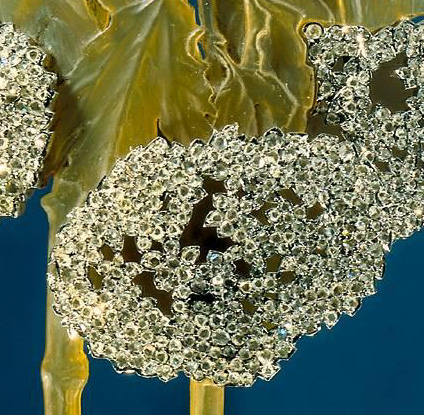
No Lalique post would be complete without an orchid. This one lives in a museum in Lisbon.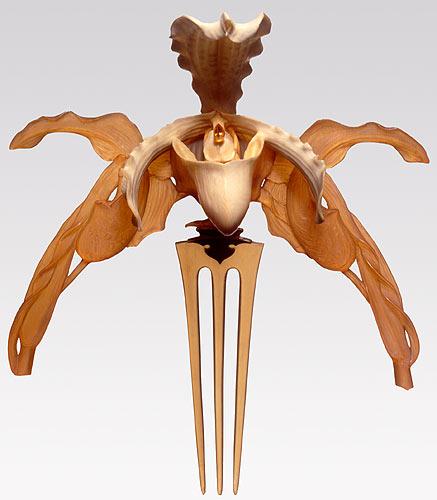
From June 23 to Nov 25 2007, The Lalique Museum in Hakone Japan will have a Special Exhibition: The Charm of Hair Ornaments – Lalique’s Combs and Japanese Traditional Kushi.” I don’t know that these particular pieces will be showcased, but there will be 20 Lalique combs made with his own hands on display. 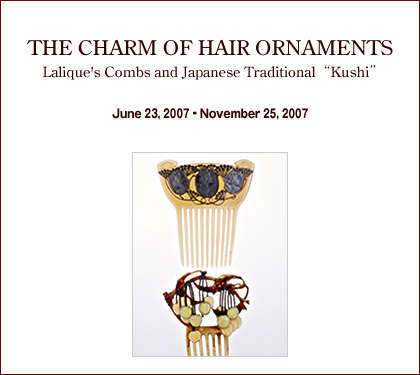
Father and Son
While Charles Lewis Tiffany’s jewelry store produced this diamond and shell comb (c.1910, sold Sothebys, 6,600 GBP, 30, March, 2006):
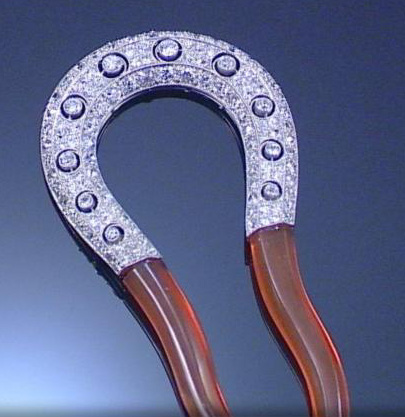
his son was changing the way the world thought about art, and made this:(Louis Comfort Tiffany comb, c. 1904, Metropolitan Museum of Art, priceless)
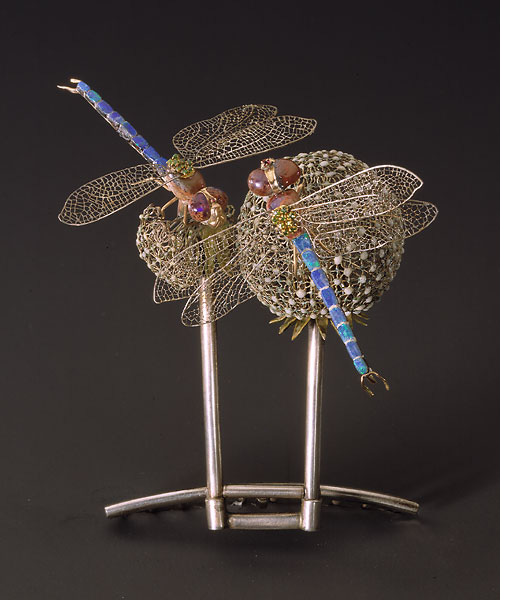
कंघी
For more scholarly research, please examine these books, which can be found in our Resource Library. I’ve also picked out some nice Tiffany & Co. silver jewelry for your enjoyment: Bead drop silver earrings, a sterling silver wire bracelet, and a Frank Gehry Orchid Drop pendant.
 The Jewelry and Enamels of Louis Comfort Tiffany |
 Louis Comfort Tiffany At Tiffany & Co. |
 The Lamps of Louis Comfort Tiffany |
Some Lovely Things on Ebay
Recently, two Japanese sets sold for $950 and $1100, respectively. They were both made of tortoiseshell in the Late Edo period. The first one has a leaf design on the kushi, while flowers rest in a field of grass on the kogai stick. It sold for $950 on July 31. You may refer to Item #330149236404.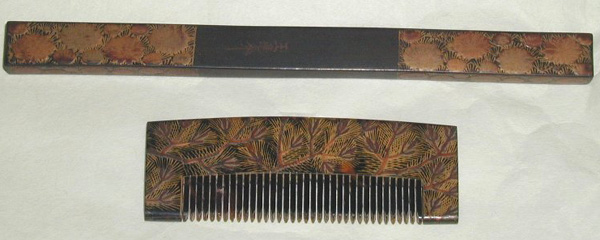
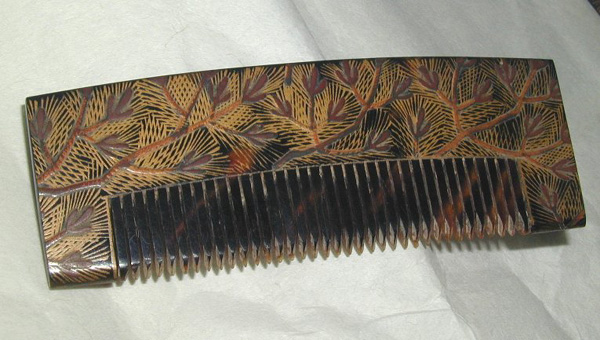
The second set had coral beads set into the kushi and kogai, as the gold maki-e decoration of flowers and leaves almost gives it the look of Imari porcelain. The kogai stick has beautiful gold and silver mounts that attach the oramental shell pieces to the stick itself. It sold for $1100 on August 2. You may refer to item #300135266043.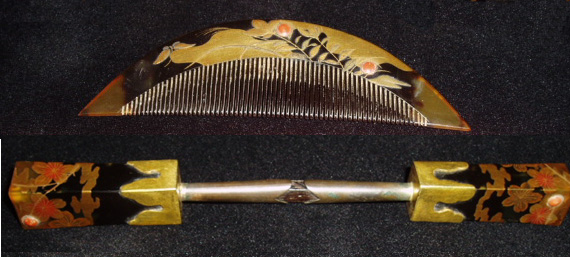
This beautiful Sterling silver comb with filigree leaves sold for $260 on July 30. I think it might be French, but I’m not sure. Comments welcome on this. I thought the design was distinctive and well balanced. You may refer to Item #160140008982.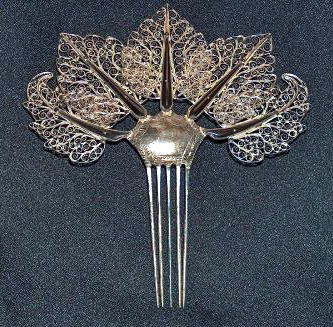
And finally today, I’ll show a comb a friend gave me pictures of. The dealer who showed it to her wanted $1200, and she is still undecided. It’s a beautiful Japanese Sterling silver, signed comb with a fish swimming in the water. Looking at the shape and size, I think it’s Meiji, although the design — one idea, and a fish — harks back to the Edo period. Comments welcome on this.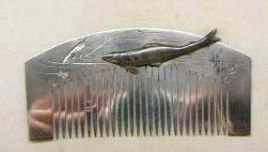
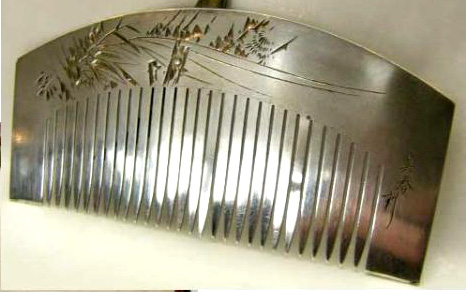
Haute Couture
I recently watched a special on PBS called The Secret World of Haute Couture. It showed some of the customers who actually bought these dresses and wore them at opera galas, charity balls (an oxymoron) and parties where they’d meet dignitaries or royalty. One woman, an heir to the Guinness fortune, said, “If a celebrity has worn a gown. I don’t want it. It’s been done.”
This had me rolling with laughter as I looked at my own drawers full of discount JJill catalog loose cotton clothing that I buy on ebay. :-) I guess none of these women sat in their vegetable gardens, picked stuff, washed it with a hose, and just sat on the ground eating things beside the neighborhood rabbits, who were eating things, too. :-)
At any rate, I thought some of the dresses of the Fall 2007 Haute Couture collections in Paris were gorgeous. It doesn’t matter that you don’t fit into the one the model wears. You just order, and they make the dress, alter the design, and do what they must so it will fit you. And all for only $100,000. ha! Well, it’s because each dress is made by the great ateliers of Paris and designed by a genius.
Here are two short dresses from Valentino.
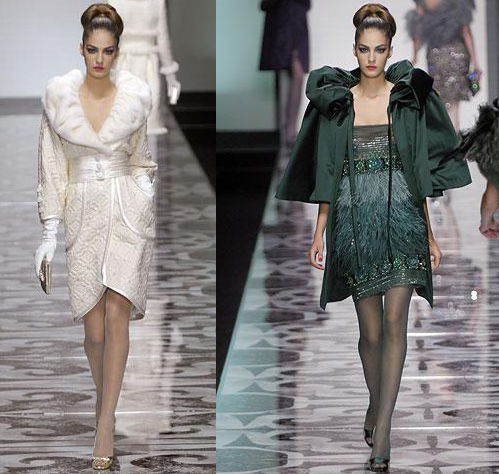
Two red evening dresses from Valentino.
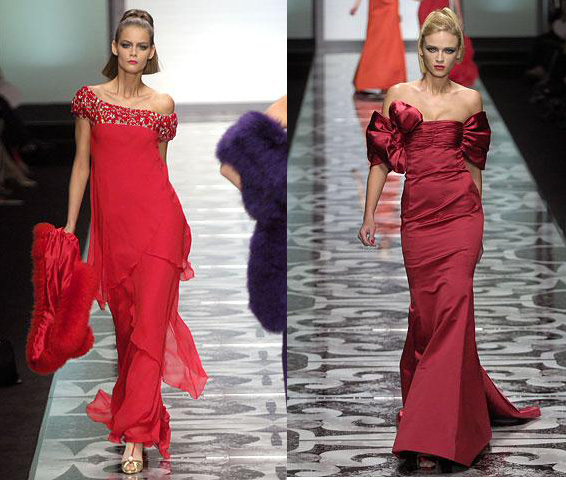
Two to-drop-dead-for evening dresses from Valentino. Look at the hand beading on these. Can you imagine the skill it took to make them?
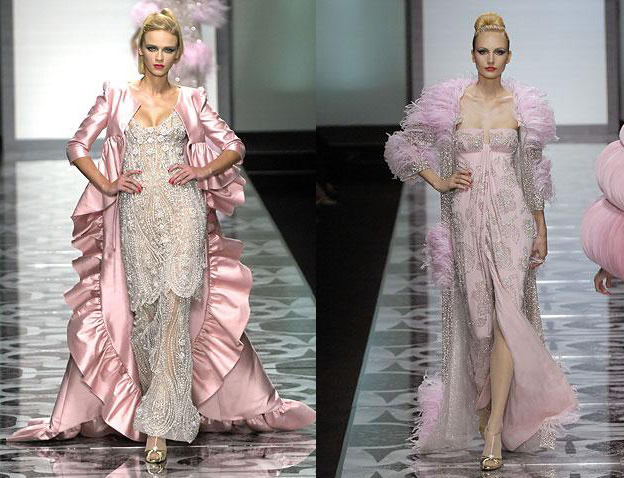
Here is a rose dress from Valentino and a black evening dress with a fabulous white cape from Galliano for Dior.
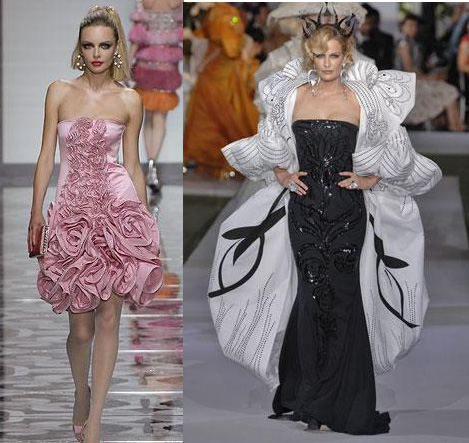
I’ll end this post with these dresses from John Galliano, right out of a fairy tale.
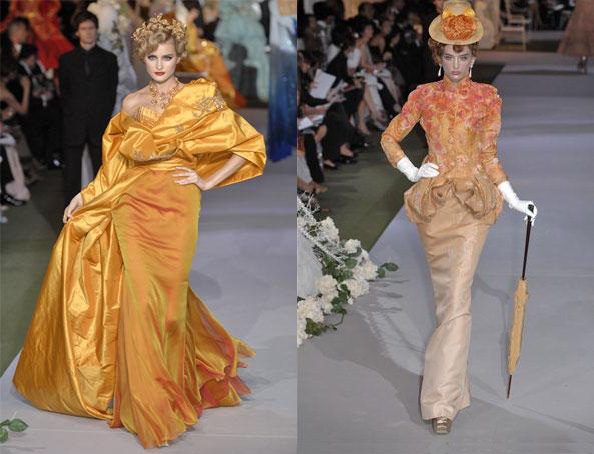
कंघी
For more haute couture style, please examine
Coral Cameo Comb
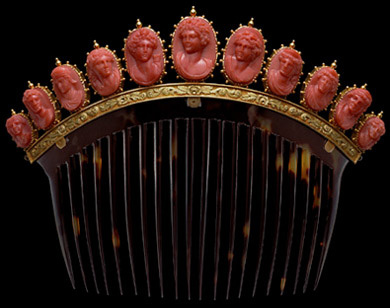
This tortoiseshell comb showcases 11 coral cameos in gold-beaded mounts, which rest on a gold base decorated with acanthus leaves, First half of the 19th Century.
Each cameo represents a divinity, or Bacchante, a priestess of the Greek God Bacchus. Bacchante cameos were popular with engravers in late-18th-Century Rome, who carved them in hardstone and shell. European travellers to Italy fell in love with them.
One hundred years later, Empress Josephine’s love of coral combined with the material’s ability to be cut into cameos might have inspired jewelers to make this design, a 19th-Century interpretation of the earlier Italian trend.
Empress Josephine loved coral’s noble rich-red color, wearing it herself and giving coral jewelry as presents. She did much to make coral fashionable in France, reflecting the French passion for classical art. Indeed, coral jewelry was considered most effective when worn with dresses of white muslin, copying the look of a Greek statue.
Some Lovely Things on Ebay
There have been some lovely silver and coral kanzashi selling for excellent prices on ebay. Very unique objects, such as a man-with-hat and an instrument, were attached to the hairpins. The Meiji man-with-hat went unsold at $350, whereas the Edo kanzashi of a Japanese traditional instrument with fish carved into the hairpin itself sold for $390. The shell bird kanzashi with gold makie went for $293. 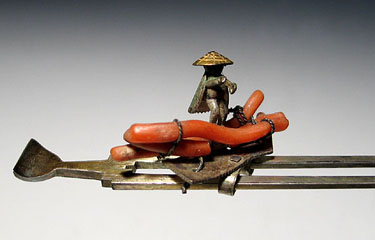
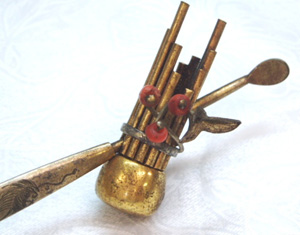
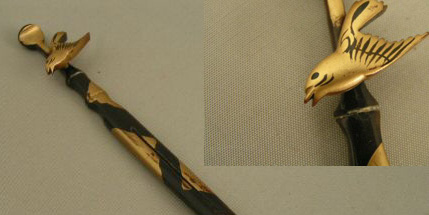
Two elaborately carved Meiji tortoiseshell kushis also sold, but at very different prices. The first one had a complex design of fans and flowers, no bug bites, and was signed. The second one had an elaborate floral design of chrysanthemums and peonies, a few bug bites, and was not signed. There was a significant price differential. Kushi #1: $577 on July 14; Kushi #2: $127.50 on July 15.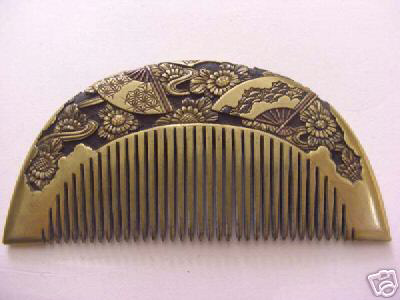
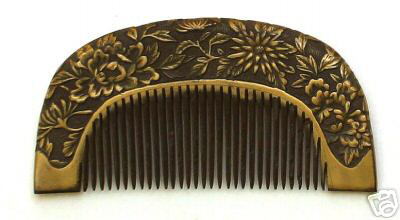
There was also a lovely brass Victorian tiara, which went unsold at a starting bid of $275.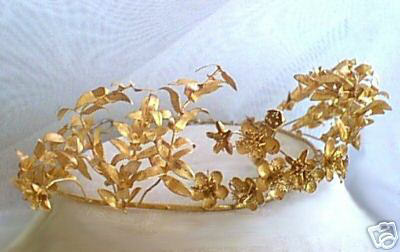
A beautifully balanced design marks this lacquer over shell signed Meiji set, which sold for $283.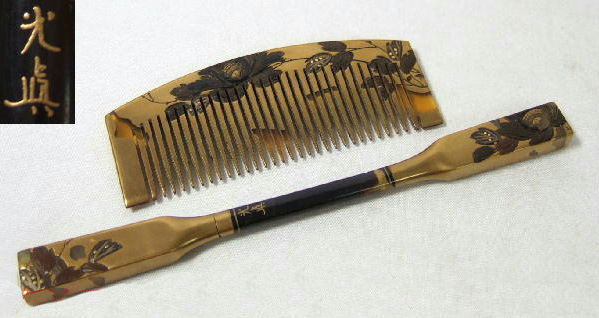
And I will end this post with two more museum-quality blond tortoiseshell kanzashi ornaments of plover birds flying over the sea.
